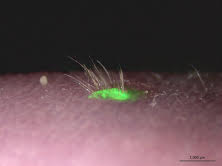In early April 2016, the renowned Dr. Takashi Tsuji from RIKEN (Japan) was yet again involved in groundbreaking new hair (and skin) related research.
Update: 2024 — Dr. Tsuji now has his own company called OrganTech.
Dr. Takashi Tsuji Interview
On April 3, I e-mailed him the following, hoping that he would grant my request for an interview:
Hello Dr. Tsuji,
I recently covered your two new partnerships (with Meiji Seika and with Adjuvant Cosmetics) as well as your paper regarding bioengineered skin.
Is there any way you would be willing to do an interview with me for my blog?
Admin
His almost immediate response:
Dear Admin,
Thank you so much for your interests to our study.
We collaborate with Adjuvant cosmetics to study on the development of a novel hair promoting agents by using our developed screening system. The collaboration with Meiji Seika pharma and other companies plan to develop a novel bioengineered skin in vitro with skin appendages including hair follicle and sebaceous gland. This bio-skin will contribute the developments to cosmetics, quasi drugs and anti-allergic agents.
Unfortunately, I would like to answer only by e-mail.
Thank you for your contact.
Sincerely,
Takashi
I was surprised that he replied (and mentioned both the companies that I mentioned in my e-mail), since he must have been extremely busy being bombarded with interview requests from around the world so soon after his latest groundbreaking paper was published. It also seemed like the ending of his above e-mail response implied that he would be willing to grant me an e-mail interview.
So I sent him a list of detailed questions. Unfortunately this time, no luck:-( Dr. Tsuji sent me a generic reply that he was sending to all journalists. I do not blame him at all of course. Below is his reply and attached FAQ file attachment that he sends to journalists.
His second response:
Dear Admin,
Thank you for your contact regarding our recent work.
I am grateful that you have great interests to our recent bioengineered skin study. Unfortunately, I enclosed FAQ, which was asked from many reporters in world-wide. I also enclosed the figure, which demonstrated successful transplantation of the bioengineered 3D integumentary system derived from GFP-expressed iPS cells. Green fluorescence indicates the bioengineered skin including iPS-derived hair shafts.
Regards,
Takashi
FAQ Document
Here is the FAQ document from Dr. Takashi Tsuji.
Lots of interesting information in there and hopefully you can download it ok. Among the highlights:
- Dr. Takashi Tsuji and his team’s latest study successfully demonstrated the proof-of-concept to induce bioengineered skin formation from iPS cells in mice.
- The transplanted whole skin could engraft and function for over 70 days in recipient mice. In addition, the resultant hair follicles repeated their hair cycles just like natural hair.
- The team plans to realize this same skin and hair regeneration technology in humans within 10 years.
The image below that he included is of “bioengineered skin with iPS-derived hair shafts”:
